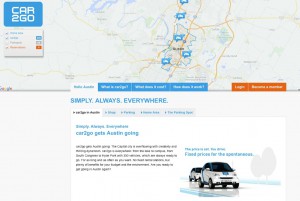
After launching with high expectations, the car-sharing service Car2go suspended operations in Miami and Miami Beach.
Despite high-expectations for the future of alternative mobility, low demand is forcing the car-sharing service Car2go to pull out of Miami and Miami Beach at the end of February.
Though it has scored well in some markets, Car2go also had to trim service in some San Diego neighborhoods, as well, to focus on that city’s more vibrant downtown area. What these setbacks mean for car-sharing on a broader scale is far from certain, but proponents still anticipate massive growth in the coming years.
Car2go tried to downplay any broader meaning to its decision to suspend Miami service as of March 1. In a statement, it blamed slow demand, in large part, on Florida’s high rental car tax. Noting that alternatives, such as ride-sharing services Uber and Lyft have gained ground there, Car2go said the tax has, “in part…contributed to a slower adoption of our service in Miami compared to other Car2go cities.”
Car2go is describing its move as a “suspension” of service, telling its customers it could yet return. There are indications the move could be aimed at pressuring state lawmakers to waive the $1 daily rental tax original put in place for the higher-priced services of traditional rental car companies. Car-sharing services like Car2go typically see customers use their vehicles for an hour or two, rather than days, at a time. And costs can run as little as $6 or so per rental.
(Cadillac to launch all-new, ultra-premium V8. For more, Click Here.)
“While we believe Miami can benefit greatly from a service like car2go, Florida’s rental-car tax doesn’t reflect the innovation we bring to the rental-car sector, making Miami one of the most expensive cities in North America for one-way carsharing,” the company told members by e-mail.
Not everyone is buying that explanation. Miami Beach Mayor Philip Levine called it “a really good excuse for a bad business model,” though the head of the Miami Parking Authority, Art Noriega, told the Miami Herald, “Our arms will be wide open to get them back.”
Car2go also had to rethink things in San Diego, where it was a car-sharing pioneer. Last November, it largely retrenched to the city’s downtown because of slow demand in some neighborhoods. At the same time, the service’s overall demand has expanded rapidly. Since it debuted there in 2011, it has gone from about 500 to 7,000 weekly rentals. About 17,000 residents have purchased the memberships needed to access the 400 vehicles based in San Diego.
(Click Here for details about how automakers set a new record for recalls in 2015.)
And that has convinced another car-sharing service, Zipcar, to sign a five-year deal with the city. The new player is Zipcar, owned by Avis. The two companies have slightly different operating rules. A user can drop a Car2go vehicle off pretty much anywhere within a defined service area, while Zipcar has defined pick-up and drop-off locations.
Proponents cite data that suggest every car-sharing vehicles displaces another 12 vehicles from the road because motorists either choose not to buy a car or they use their own vehicles less frequently.
The concept has growing appeal. General Motors this week launched the new Maven car-sharing service which will initially focus on a handful of megacities and college towns – including New York, Frankfurt and Ann Arbor, Michigan.
GM also acquired ride-sharing service Sidecar and invested $500 million in Lyft, the largest competitor to the segment’s leader, Uber.
(To see more about GM launching car-sharing service called Maven, Click Here.)
Carmakers such as Daimler, which has a major stake in Car2go, see two key opportunities in the car-sharing business. They hope to earn revenues in a booming sector where they didn’t previously compete. And they’re betting that many clients eventually will buy a vehicle. Daimler, for example, hopes that Car2go customers will like, and later opt for, a Smart car.
